Great Vow Zen Monastery Invites All People
To Make Life Vows at the Shrine of Vows
Written by: Patrick Bansho Green
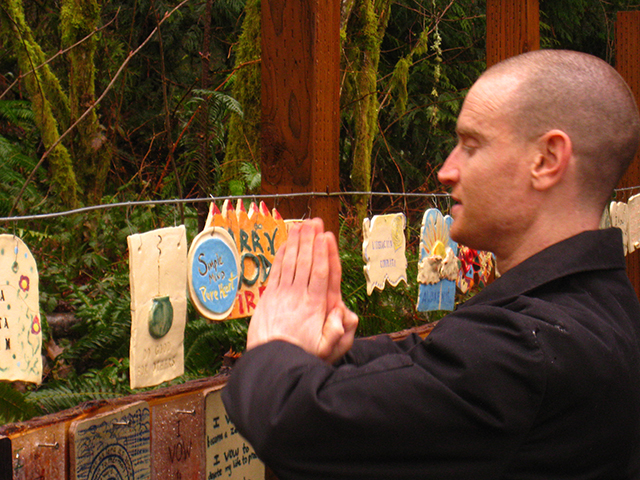
Great Vow resident priest Jogen Salzberg chants after placing his vow on the wall surrounding the Shrine of Vows.
Photos by – Hogen Bays
Under a rainy January sky, Great Vow Zen Monastery dedicated an outdoor area of the monastery called the Shrine of Vows. This is a place where people can go to formally set a life intention, and leave a physical marker of their aspiration, such as a painted stone or ceramic tile.
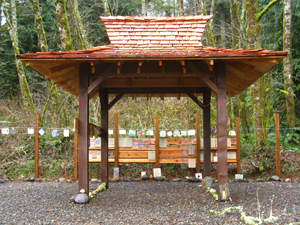
The Shrine of Vows at Great Vow Zen Monastery in Clatskanie, Ore.
The Shrine of Vows is located at Great Vow Zen Monastery in Clatskanie, Ore., 80 miles northwest of Portland. The monastery sits atop a wooded hill overlooking the Columbia River. For over 10 years, priests in training and residents have kept a monastic schedule there.
Great Vow has always been “permeable,” meaning that it is open to visitors: long-term residents as well as short-term guests who come for retreats and workshops. Many come to its forested Jizo Garden, where people visit to memorialize those who have died, especially children.
A vow is a commitment to see something through no matter how long it takes. It may be something that is time-limited, like a vow to complete education. Or it could be something much larger.[1]
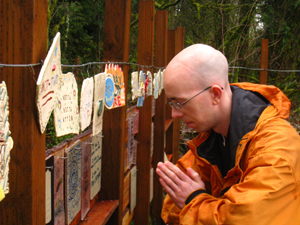
Ryushin Creedon, priest at Heart of Wisdom Zen Temple, bows as part of the ceremony dedicating Shrine of Vows and opening it to the public.
Great Vow Zen Monastery gets its name from Jizo/Chenrezig/Dizang Bodhisattva’s “Great Vow.” This is a vow to be present with and benefit all suffering beings in all realms, and to continuously benefit others until “the hells are empty.”
Every January Great Vow holds a week-long silent retreat (sesshin) called Life Vows, which follows a modified sesshin schedule. In this retreat, participants each day take a little time out of noble silence to discern and discover their own life vows, with the support of a small group.
What is important in our life? And are we moving in a direction that reflects our vows?
Zen Teacher Hogen Bays, the co-abbot of Great Vow, was inspired to create the Shrine of Vows after a Zen Community of Oregon pilgrimage to Buddhist temples in China. At many temples and other places you find hundreds of metal padlocks brought by people to “lock in” a vow or promise.
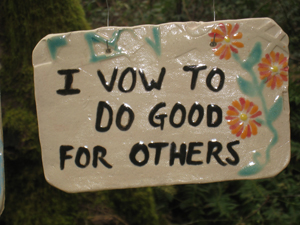
A vow of love.
The padlocks symbolize commitment to raise a child, to end addictive behavior, or to keep a private promise. Many locks are inscribed with the names of couples, who thereby memorialize their commitment to one another.
Hogen wanted to create a similar place in the United States where anyone, Buddhist or not, could come and make a physical expressions of their aspirations.
People write their vows on paper, or carve or paint them on ceramic tiles or other media. They then can hang their vows around a Japanese-style open air shrine constructed by Bill Dainen Kelley, a lay member of the Great Vow community.
The Shrine of Vows is located across a meadow, in an area hand-cleared of invasive blackberries and surrounded by old conifers. Already, scores of tiles and painted stones anonymously express people’s vows: “I vow to help others,” “I vow not to give up my spiritual quest,” “I vow to listen closely to the joys and sorrows of the world.”
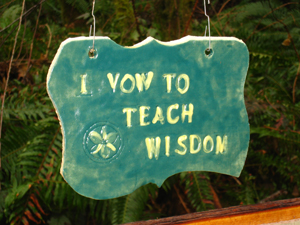
A vow of wisdom.
Seeing all the many vows from others inspires us to discern and share our own vows.
What is a vow?
A vow is a deep commitment to see something through no matter the obstacles.
A vow is different from a new year’s resolution. Resolutions have the air of self-improvement while vows speak to something larger. Vows ask us to continually return, over and over again, to our deepest intentions. Vows help us orient our life to what is most beneficial. And vows emerge from our own unique life and circumstances.
Great Vow Zen Monastery’s founder Taizan Maezumi Roshi was once asked about what happens when we die. He replied that while the physical body may die, it is our vows that live on after death.

A participant of the week-long retreat on life vows, shows his hand-made tile to be placed at the Shrine of Vows.
Why make a vow?
We recognize that we can become easily distracted and go off course. Vows can bring us back to what is really most important and essential. Vows help us align our life with intention leading to action that benefits others and ourselves.
Some types of vows and examples
Short-term: to complete school, training or an apprenticeship, to embark on a journey, or complete some project.
Family or community vows: promising to care for a parent for as long as we are able; to raise and care for a child; to help people in abusive situations, to care for the Earth.
Ethical Vows: to uphold the Buddhist precepts or specific precepts; to speak kind words even to difficult people; to resolve unwholesome actions and live with integrity; to make amends to beings we may have harmed.
The Shrine of Vows is open to everyone in the wider Buddhist community, and to anyone else who wants to participate by leaving a token of their own deep intentions. For more details contact Great Vow Zen Monastery.
